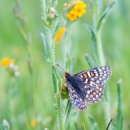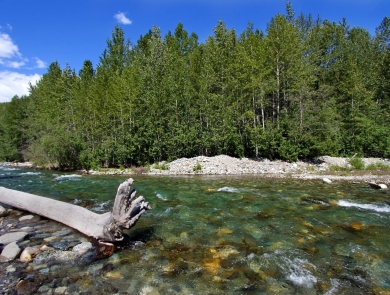Birds are sensitive during the nesting season. Vegetation clearing, ground disturbance, heavy wake near shorelines and other site construction and recreational activities can destroy eggs or nestlings or cause nest abandonment. If you encounter an active nest, leave it be and give it space until young hatch and depart the area. Do not destroy eggs, chicks, or adults of wild bird species. Learn about the laws that govern migratory birds in Alaska including possible exceptions for subsistence gathering. More information on avoiding waterbird harassment and timing recommendations for construction activities to minimize impacts to nesting birds.
About Us
Our staff work in an area that stretches across the northern part of Alaska.
What We Do
We specialize in ecology, biology, fisheries science and management, project evaluation and mitigation, statistics, environmental contaminants, and working with federally-qualified subsistence users. We work side-by-side with myriad partners to understand, protect and restore aquatic resources of northern Alaska, assist management of subsistence fish species and uphold the U.S.-Canada Yukon River Salmon Agreement, assess, minimize and mitigate the impacts of large-scale development projects, recover listed eider species, restore degraded habitats, and build positive relationships with others to conserve fish, wildlife and their habitats for the American people and future generations. Some of the services we provide within the communities we serve include technical assistance, funding, and conservation capacity and guidance.
Our Organization
Projects and Research
In the spring of 2004, thawing permafrost caused a large landslide (slump) in the upper Selawik River within Alaska's Selawik National Wildlife Refuge. As the slump grew it discharged tons of sediment upstream of the Selawik sheefish population's spawning grounds. This fish is an important Refuge fixture and year-round subsistence food for the Inupiat people living in the Selawik/Kotzebue...
When woolly mammoths still roamed Earth, rain and snow fell on the south side of Alaska’s Brooks Range. Those same ancient waters are just now entering frozen rivers on Alaska’s North Slope via perennial springs. And they hold the key to survival for salmon-sized Dolly Varden and several other species of fish in Arctic National Wildlife Refuge.
Read more about Alaska's North Slope...
This multi-year project has sought to reconnect habitat and restore fish passage in Fairbanks, Alaska.
Cripple Creek’s natural channel was abandoned in 1935 when streamflow was diverted into an artificial drain constructed to carry wastewater and sediment from hydraulic mining activity in the Ester area. Though mining activity ceased years ago, the drain channel...
The Federal Subsistence Board has given Delegated Authority to the Federal Inseason Fishery manager to manage subsistence fishing for salmon in all Federal Public waters of the Yukon Area.
The Federal manager and a team of assessment and management biologists work together with State of Alaska managers, Office of Subsistence Management staff, Regional Advisory Councils, USFWS Refuge...


















